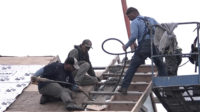Designing Fall-Arrest Harnesses, an Entrepreneur Aims for Safer Dangling Time
Tragedy sparked a new idea about safety for Max Wilhammer, who creates customized fall-protection harnesses including some that provide longer protection for dangling construction workers who have fallen and been saved by their harnesses.
Hanging in a harness after a fall for more than five minutes in an upright posture, with legs relaxed straight beneath the body, can cause serious injury or death, according to Occupational Safety and Health magazine. Wilhammer says that severe injury is possible after eight to 12 minutes. Others have put the time until injury at 14 minutes in a full-body harness.
Wilhammer knows the dangers from personal experience. Twenty-four years ago at age 17, while working as an apprentice painter on the twenty-second floor of a Nashville high-rise, Willhammer found a co-worker hanging from his safety harness. He had fallen from a ladder and was dead.
Wilhammer thought the man, an electrician, had hung himself. “It didn’t make any sense to me,” Willhammer says.
Apparently, the electrician had died after his fall because the straps of his safety harness had acted as tourniquets. The condition, Willhammer later learned, is called orthostatic intolerance. It is the cause of suspension trauma.
In the upright posture with legs immobilized, gravity pulls blood to the legs, cutting the return flow to the heart. With the heart’s output cut, and the heartbeat slowed, too little blood may reach the brain.
Two years later, Willhammer was on the job as a security guard at a powerplant, working seven stories up, when he saw a worker try to adjust a bolt. The worker lost his footing and fell several stories, striking several objects as he fell.
A Vision Is Ignited
Those two accidents ignited a vision in Wilhammer, who started sewing his own safety harnesses, doing the stitch-work in his spare time.
“People shouldn’t die just going to work,” he says.
Now 41, the native of Idaho Falls lives in Burbank, Calif., and is busy promoting his own line of safety harnesses via his company, Willhammer Industries.
In December, the television program "Invention USA" featured his three-piece Air Trek harness. The show’s co-hosts agreed to fund his prototype safety harness, and encouraged him to create a lower-priced version.
He has since created a less expensive version, the Fall Master, which sells for $199.99.
The Fall Master is designed as a safer harness meant to compete with other harnesses now on the market. It includes padded shoulder-blades, a padded back-brace and a tool belt. The harness has both front and rear fall mounts.
Willhammer’s safety harnesses lessens the possibility that the straps, and the pressure they inflect on the human torso, will inflict life-threatening injuries to a dangling worker who’s fallen.
Other companies, such as Capital Safety, also offer safety harnesses designed for enduring long rescue waits, including harnesses with seat slings suited for communications tower work, and some with deployable foot loops for helping prevent suspension trauma.
Wilhammer says he will be taking a different approach. “Capital Safety is a big company with more resources than me so they carry many more products. I am proud that they have been there for workers and have spent time on their new harnesses, but I do not think they see the world with the same eyes.
"I want to offer more unique custom harnesses than any other company, giving the best possible harnesses for the people that need them."
When a worker's fall is arrested, the person will most likely be in pain from muscle trauma, says Wilhammer, if he or she has been using a standard safety harness.
"They will most likely be begging anyone that can to get them down because each minute causes much suffering."
Ben Walsh, former safety officer for Selectbuild Inc., who now works for the state of Idaho, applauds Willhammer’s harnesses. “These harnesses are customized for their specific field of application...[and that's] what set them apart,” Walsh says.
Wilhammer is on to a powerful breakthrough here. His commitment and drive are obvious. The death of a co-worker is a passionate motivator. Max is saving lives. Look at the conversat...
For falls involving a dozen or so feet,typically falling a floor or falling off a ladder it is very practicable to<br/>have some padding in the fall zone. The human body has a reserve o...
have some padding in the fall zone. The human body has a reserve of the order of 100 g's or more as is amply proved for example by "indy" racing car drivers where the recorded instrumentation shows they
have survived sudden decelerations of over 100 g without injury.
For example imagine padding that is crushed just 1 inch from a fall of 12 feet. The deceleration is
120 inches/1 inch = 120 g's which is likely to be survivable without permanent injury.
Falling from a height of 10 feet, not 12 feet and being decelerated in a crush space of 1 inch results in <br/>120 g's. I am sorry for my error.
120 g's. I am sorry for my error.
Whether higher quality safety harnesses will be used in construction depends on OSHA standards, which change very slowly, and cost. It will be interesting to see if Wilhammer can make i...
In the above article about Willhammer harnesses, it is stated that the harnesses are manufactured to OSHA standards, and in fact they meet or exceed all specifications currently legally...
The only thing that changes slowly is the rights of workers that are many times treated as expendable leading to death quotas with all major construction projects.
There will always be people trying to save a buck, so the bottom line will always be how much is your life worth?






